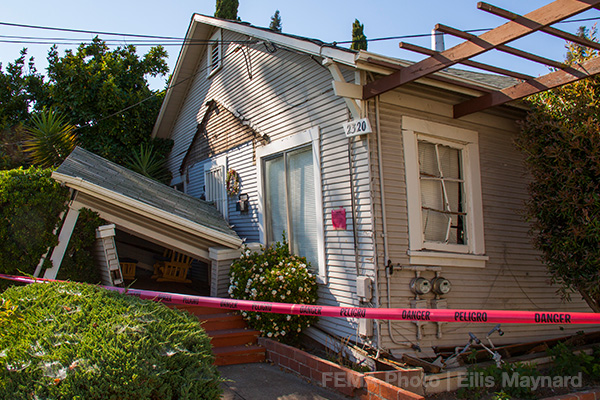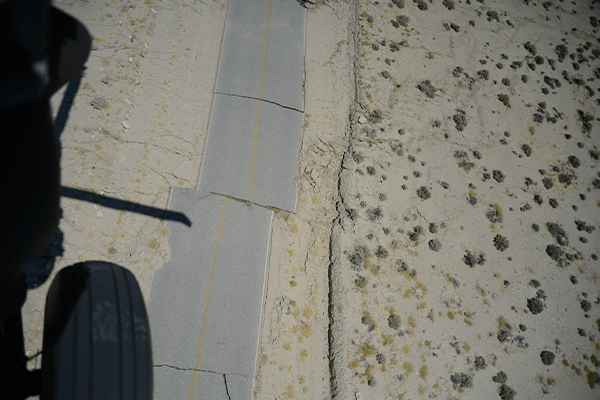When it comes to earthquake damage and earthquake destruction, the primary culprit is the strong ground shaking produced by the quake itself. This results in contents and buildings falling and power lines toppling, which can, in turn, result in injuries to people and damage to property. It is that same shaking that can lead to other earthquake damage facts and phenomena, such as ground rupture, tsunamis, tidal waves, landslides, liquefaction, and fires.
What happens in an earthquake?
According to the United States Geological Survey (USGS), an earthquake happens when two blocks of the earth suddenly slip past one another. The surface where they slip is called the fault or fault plane. The location below the earth’s ground surface where the earthquake starts is called the hypocenter, and the location directly above it on the surface of the earth is called the epicenter. The scientists at USGS dive even deeper to explain in simple terms what causes earthquakes and why the earth shakes when there is a quake.
What are seismic waves or earthquake waves?
Seismic or earthquake waves are produced when an earthquake occurs. The seismic waves are what cause the shaking. An earthquake produces several different kinds of waves, with each known for its speed and potentially destructive effects. The University of California, San Diego’s Satellite Geodesy site defines the characteristics of the different types of seismic waves and describes the waves as the “jiggling of the ground in response to the force put on the ground by the earthquake, similar to the way the Jell-O in a bowl responds to the tap to the side of the bowl.”
P waves, or primary waves
The P stands for primary or pressure. These waves are fast as they travel through rock and water at very high speeds. They push, pull and compress the earth in the direction of their travel, moving the ground back and forth in a vertical motion.
S waves, or secondary waves
The S stands for secondary or shear waves. These waves move slower than P waves but can be much more destructive. S waves move the earth in a perpendicular fashion to the direction the wave is traveling. To gain a better and simpler understanding of the difference between P waves and S waves, USGS compares P waves to lightning and S waves to thunder.
Surface waves (Love waves and Rayleigh waves)
Surface waves can do the most damage as they occur when the energy of the quake reaches the ground surface of the earth. Surface waves consist of Love waves and Rayleigh waves. Love waves shake the earth from side to side, while Rayleigh waves churn under and over like rolling ocean waves. (Love and Rayleigh waves are named after the individuals who discovered them.)
Which seismic wave is the most dangerous and why?
Surface waves—that is Love and Rayleigh waves—are considered to be the most dangerous and destructive because they can cause the strongest ground shaking. They are the waves often blamed for making buildings collapse.
What are some of the destructive effects of an earthquake?
Just how dangerous are earthquakes? In a matter of seconds, earthquakes and the hazards they produce can turn the lives of people upside down. The destructive effects of an earthquake can injure and kill people, destroy property, rupture gas lines causing fires, and upend communities. Our previous blog titled “What are Earthquake Hazards?” details the various seismic hazards resulting from a large earthquake.
What makes earthquakes so dangerous?
The violent shaking of the ground leads to the destructive effects of earthquakes. The ground shaking is what triggers the vicious cycle of ruptures in the earth, which can result in landslides, tsunamis, tidal waves, liquefaction and fires. All these together, or individually, can lead to the damage of personal property, infrastructure, and loss of lives, demonstrating the widespread extent of earthquake destruction.
How earthquakes cause damage
While ground shaking is primarily to blame for the damage caused by earthquakes, it is not just the immediate area that is vulnerable to ground rupture, landslides, tsunamis, liquefaction, and fires. A large earthquake can wreak havoc that can be felt hundreds of miles away. When earthquakes of magnitude 6.4 and magnitude 7.1 struck the Mojave Desert town of Ridgecrest on July 4th and July 5th, 2019, various levels of shaking were broadly felt as far away as San Diego to the south and Sacramento to the north. Fortunately, no people died in the Ridgecrest quakes.
What factors cause some earthquakes to cause more damage than others?
Several factors determine how destructive an earthquake can be. According to an article in Smithsonian Magazine, those include an earthquake’s location, magnitude, depth, distance from the epicenter, local geologic conditions, strength and architecture of homes and buildings. Generally speaking, deeper earthquakes are less damaging because their energy lessens before it makes it to the surface.
When it comes to earthquake damage in California, raised foundation homes built after 1980 generally can stand up better to the ground shaking from quakes because it was after 1980 that meaningful building codes were put in place.
For other types of vulnerable homes, such as homes with rooms over garages and homes on steep slopes, a seismic retrofit can make a difference in making the dwelling more resistant to damage caused by earthquakes.
What magnitude of an earthquake causes damage?
Earthquakes in California are a fact of life, and they occur in the Golden State on a regular basis. Quakes are measured by their magnitude, intensity and release of energy. Earthquakes release energy in the form of seismic waves. A scientific instrument called a seismograph, or seismometer, in some cases can send a digital recording of the ground shaking and motion produced by the seismic waves. Seismographs both measure and detect the duration of the quake’s waves. Additionally, the seismograph creates a type of digital tracking of the event’s ground motion called a seismogram.
The size of an earthquake is called its magnitude. Of note, the magnitude of an earthquake does not rely on the location where the measurement is made.
Quakes are often categorized ranging from “minor” (for magnitudes between 3.0 and 3.9) to “great” (for magnitudes greater than 8.0). Some quakes, including those with a magnitude of 3.9 or less are often so small they cannot be felt, while large earthquakes greater than a magnitude of 8.0 typically cause significant earthquake destruction. There are different impacts depending on the six different classes of earthquake magnitudes, including those within the range of 4.0 to 7.9 magnitudes.
Prepare for Quake Damage and Strengthen Your Home
Over the last 33 years, significant, high-profile earthquakes in the Bay Area (Loma Prieta in 1989), the San Fernando Valley (Northridge in 1994), Ridgecrest in the Mojave Desert in 2019 and Napa in 2014 have caused damage and destruction in and around those communities. History and science tell us that California is an earthquake-prone state and that the next major earthquake can happen at any time. While the next earthquake in the Golden State is inevitable, the resulting damage and destruction to property can be mitigated by being better prepared. To learn more about how you can better prepare yourself, your family and your property before the next major earthquake strikes, check out how to Strengthen Your House.


